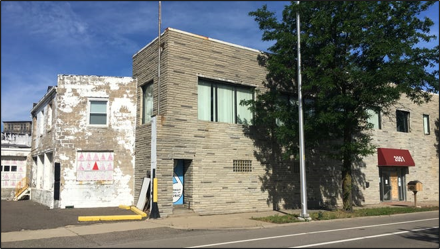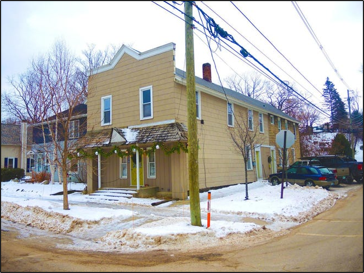Institutional Controls and Implications for Policy
Researchers from the IWR and FLOW are in the final stages of a study looking at the long-term costs of implementing institutional controls (ICs) as a groundwater contamination response in Michigan.
Researchers from Michigan State University’s Institute of Water Research (IWR) and FLOW (For the Love of Water) are in the final stages of a study looking at the long-term costs of implementing institutional controls (ICs) as a groundwater contamination response in Michigan. The project was funded by the Michigan Department of Environment, Great Lakes, and Energy (EGLE)’s Office of the Great Lakes through the Michigan Great Lakes Protection Fund.
What are institutional controls?
Institutional controls (ICs) aim to protect people from harmful exposure to contaminants that are left behind from previous industry. Michigan's cleanup laws and standards are risk-based and reflect the potential for human health or ecological risks from exposure to potentially harmful substances at contamination sites. A cleanup may include the implementation of ICs to prevent unacceptable exposures in order to achieve the cleanup objectives. ICs are typically put in place through the form of deed restrictions or municipal ordinances. In the context of groundwater, ICs prohibit contaminated groundwater from being used as drinking or irrigation water, preventing the installation of new wells, abandoning existing wells for affected households and therefore requiring connections to municipal water sources. In addition to drinking water exposure risks, there is potential risk from vapor intrusion. Vapor intrusion is the process of vapors migrating from volatile chemicals in contaminated soil or groundwater through subsurface soils or preferential pathways (such as underground utilities) and impacting the indoor air quality of any overlying buildings.
ICs can be more affordable for the liable party than more aggressive approaches such as groundwater extraction and treatment. However, leaving the contamination in place and simply restricting access to the affected groundwater can have long-term impacts that are difficult to account for and are often overlooked in the initial remedy selection process. These impacts may include restrictions on future development, decreased real estate values, and unanticipated health or environmental risks as the polluted column of water, called a plume, migrates away from the original source of contamination over time. Additionally, although ICs may be more logistically feasible than alternative mitigation approaches, they require long-term commitments of monitoring and maintenance from stakeholders, adding to their long-term cost. Complicating the issue is the fact that Michigan has thousands of contaminated sites at which the liable party is either bankrupt, insolvent, or deceased. In these instances, the state takes over addressing the site and must decide how to allocate its limited resources to maximize the protection of public health.
Methods and case studies
The project partners at the IWR and FLOW have identified seven case study sites in which an IC for groundwater was used in Michigan and are estimating the cumulative cost of that choice at each site, including those associated with monitoring, wildlife impacts, property value, public health, and recreational loss, among others. "The long-term impacts of institutional controls is not a subject that has received sufficient attention in the research community, and it is not a problem unique to Michigan. We hope this project can address that gap and provide some useful insights to communities that may have to consider how best to respond to groundwater contamination,” said Dr. Steven Miller, project partner and MSU professor of agriculture and resource economics.

Two examples of the selected case study sites include Lincoln Brass Works in Detroit and the Charlevoix Municipal Well Field in Charlevoix.
Lincoln Brass Works was a former brass casting site operating in Detroit from 1917-1993 involved in casting, grinding, machining, assembly, testing, plating, and parts cleaning (hence the use of degreasers). In 1997, a restrictive covenant (a form of an IC) was adopted that required maintenance of all existing barriers, prevented the installation of new wells, and restricted soil disturbance. However, the restrictive covenant lacked detail on the type of land uses that were prohibited for the site, such as schools or daycares. In 2016, a daycare program being run out of a building located on top of the contamination left in place at the site was closed due to vinyl chloride vapor intrusion into the building. Groundwater was not encountered with subsurface investigations, and municipal water is supplied at the property; however, vinyl chloride in the soil led to vapor intrusion exposure risks in the building. “Lincoln Brass is an interesting case because it highlights a lack of specificity in some restrictive covenants and how awareness of past contaminations can be lost through transfers of ownership, ultimately exposing a vulnerable population to a dangerous chemical,” stated Connor Crank, a project administrator at MSU’s IWR.

The Charlevoix Municipal Well Field is an EPA Superfund site in Charlevoix, Michigan. In 1981, trichloroethylene (TCE) and tetrachloroethylene (PCE), two chemicals that are widely used for metal degreasing and glue solvents, were found in the groundwater. The source of the contamination was from multiple industrial and commercial sources around the city, including a former dry-cleaning site. In 1984, the EPA allowed the contaminated groundwater plume to discharge into Lake Michigan under natural conditions. An existing county sanitary code functioned as an initial IC by prohibiting new wells, followed by a more expansive city ordinance in 2008. In 1986, the State of Michigan installed air sparging systems to protect surface water, and in 1993 the EPA delisted the site from its Superfund. However, throughout the 1990s the State continued to install soil vapor extraction systems, and in 2001 the EPA acknowledged that the site was still in need of remedial action to protect human health. In 2011, PCE vapor intrusion was found in 16 buildings and the EPA installed sub-slab depressurization systems as a mitigation effort. In 2022, the EPA estimated that the groundwater contamination will take 35 years to reach acceptable levels.

Implications for future policy
The insights gained from this study are being used to develop a decision framework to guide future evaluations of responses to groundwater contamination. The framework will supplement existing remedial or corrective action processes described in the State of Michigan’s cleanup programs, incorporate the economic schema and policy implications of long-term use of ICs, and facilitate the comparison of IC costs versus more aggressive remedial or corrective actions. "Our hope in this project is to ensure that sole reliance on institutional controls does not become a default response to groundwater contamination. ICs serve an important role in protecting the public from groundwater contamination, but their long-term impacts, both economically and environmentally, should be carefully considered prior to their implementation,” stated Dr. Glenn O’Neil, project manager and environmental scientist at MSU’s IWR. A final report will be available in late 2023.



 Print
Print Email
Email




